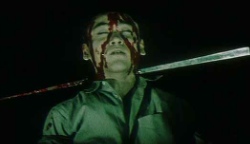
 At a time before the word “horror” even had a translated equivalent in Japan, writer/director Nobuo Nakagawa gave the country something to be all shook up about: a cinematic trip to Hell, and one full of gore of that! Jigoku is a real freaker-outer, starting with credits that suggest an Asian 007 adventure, but only if the guy in the audio booth tripped and fell on every SFX button at once. Your ears will hate it.
At a time before the word “horror” even had a translated equivalent in Japan, writer/director Nobuo Nakagawa gave the country something to be all shook up about: a cinematic trip to Hell, and one full of gore of that! Jigoku is a real freaker-outer, starting with credits that suggest an Asian 007 adventure, but only if the guy in the audio booth tripped and fell on every SFX button at once. Your ears will hate it.
But your eyes will love it! College student Shirô (Shigeru Amachi, The Tale of Zatoichi) is having a bad run, starting when a drunk yakuza fatally stumbles into path of the car in which Shirô is a passenger. Then his fiancée dies in a wreck, so he drowns his sorrows in the bodily fluids of prostitutes. Then his mom falls critically ill. Then he becomes partly responsible for the deaths of several more people.
 Finally, with a little more than half an hour to spare in the running time, he goes to Hell. Worse, Buddhists believe in a Hell comprised of eight Hells, so buckle up! Upon arrival, he gets his throat pierced, has to view a Your Life’s Greatest Fuck-Ups reel and learns just how hot flames of eternity can be. Shirô gets the 25-cent tour and sees the newly dead being flayed, boiled and spiked for punishment — different strokes for different folks, all rather graphically depicted with lots of red acrylic paint.
Finally, with a little more than half an hour to spare in the running time, he goes to Hell. Worse, Buddhists believe in a Hell comprised of eight Hells, so buckle up! Upon arrival, he gets his throat pierced, has to view a Your Life’s Greatest Fuck-Ups reel and learns just how hot flames of eternity can be. Shirô gets the 25-cent tour and sees the newly dead being flayed, boiled and spiked for punishment — different strokes for different folks, all rather graphically depicted with lots of red acrylic paint.
Weird and wild, Jigoku does drag in the middle, kinda like life itself. But its Hell sequence — if one could call a third of a film a “sequence” — is quite something to see, from both a visual and a historical standpoint. I would’ve loved to witness how it went over with audiences upon release. However, if you want to see some really crazy Asian shit without the heavy-handed morality tale but with all of the “Huh?,” 1977’s Hausu is your best bet. —Rod Lott

“Jigoku” is trippy as all get out, but I’ve still got to see “Hausu.” What of “Onibaba,” by the way? Is it worth tracking down as well?
Great question! I’d like to know, too.